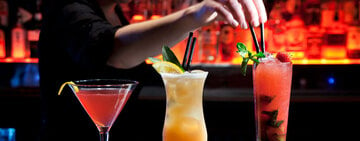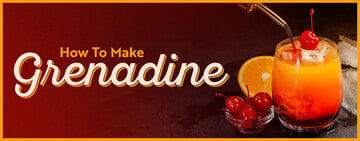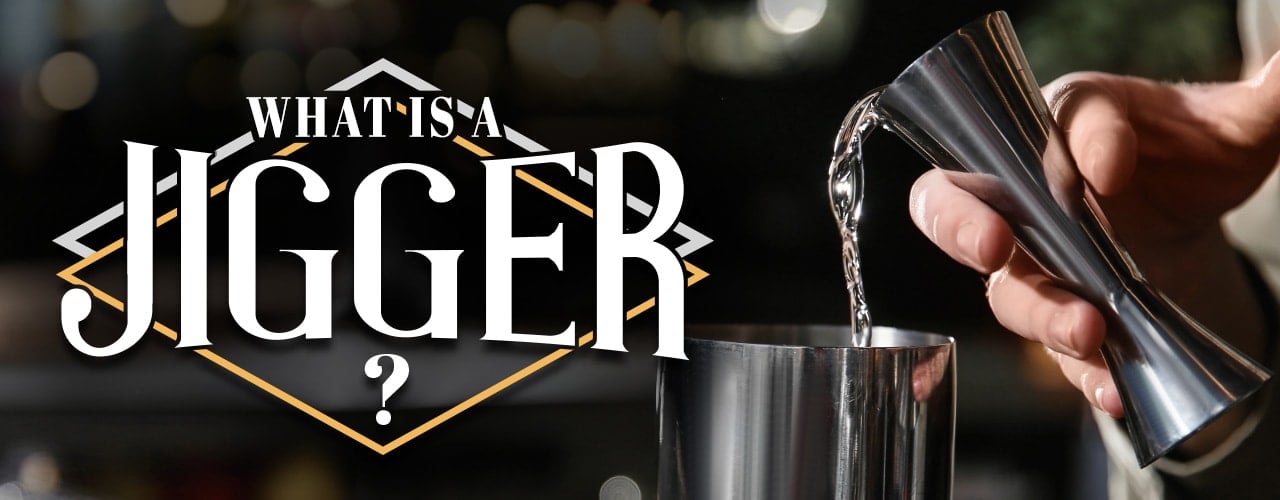A jigger is a common bar essential that acts as a cocktail measuring cup. Jiggers are dual-sided and help bartenders cut down on overpouring and remain consistent when crafting cocktails. They have different capacities on each end and range from 0.5 to 2.5 ounces. One of their main advantages is that jiggers are dual-sided and allow bartenders to quickly mix drinks while using both sides of the jigger.
Shop Bar JiggersHow to Use a Jigger Video
Watch the video below for a step-by-step breakdown of how to use a jigger.
Jigger Measurements

There are several different sizes of jiggers and you should always double-check jigger measurements when following a cocktail recipe. A jigger in one cocktail recipe can differ from an amount in another. You should also hire a bartender who is familiar with jigger measurements and how they range in size. A standard jigger is 1.5 oz. and 0.75 ounces on either side. The most common jiggers are 1.5 x 0.75 oz. and 2 x 1 oz.
How Many Ounces Are in a Jigger?
Typically, the larger end of the jigger is 1.5 ounces and the smaller end is 0.75 ounces. In most cases when people refer to a “jigger” or a “jigger shot” they are referring to the standard jigger size of 1.5 ounces. The smaller end of the jigger is known as a pony shot.
How Many Ounces Are in a Shot?
A shot is typically 1.5 ounces, which equates to one standard jigger. Shot glasses can be used for drinking or measuring. They come in an array of different sizes and shapes that can be used for multiple purposes.
Jigger Styles

Jiggers can come in various styles and types. Depending on what type of drink you're making, a different jigger may be best suited for the job. Below we take you through two common jiggers.
Double Jiggers
Double jiggers are the traditional style of jiggers and are also referred to as the basic bar jigger. They feature the standard hourglass shape and come in a variety of different sizes.
Japanese Jiggers
Japanese jiggers are tall with a sleek, narrow shape and a thin diameter. Because of their thin style, they are easy to pour from, but they can be difficult to pour liquor or syrup into.
Whether you are mixing cocktails or stocking your bar, jiggers are essential to include in your back-of-bar inventory. These bar measuring tools will ensure bartenders are pouring consistently when mixing recipes and providing a quality drink to customers.
Related Resources

How to Set Drink Prices In Your Bar or Restaurant
Setting bar drink prices can be a challenging part of managing a bar. Customers may be deterred by overly high prices, but the business will struggle to thrive if prices are too low. Factors such as rent and overhead costs need to be factored in when determining pricing, along with industry standards that can guide you in setting the right prices for your establishment. Use our guide to calculate drink prices at your bar to encourage purchases and maintain a steady profit. How to Price Cocktails Pricing cocktails and other drinks requires a few simple equations. When considering how many different types and brands of liquors are used, follow these steps to help you estimate the price of the drinks at your establishment. Liquor cost calculation: Bottle Price / Ounces in Bottle = Liquor Cost per Ounce Pour and beverage cost calculation: Cost to Make the Drink / Price You Sell It for = Pour Cost. Industry-standard pour costs range between 20% to 25%, but adjust the percentage to match your business. Drink price calculation: Liquor Cost / Pour Cost in Decimals = Drink Price Add garnish prices: Some bars calculate the cost of each ingredient and price them accordingly, while others set a flat rate and add it to the cocktail price. Calculate shrinkage variance: Most bars will add an additional fee of approximately 20% to cover the cost of lost products due to expiration or damage. Round total price to the nearest quarter: To make the calculated price more visually appealing, round to the nearest quarter to create a cleaner drink menu. Evaluate and adjust: The prices you come to may not always be the most cost-effective price for your demographic. You can use a profit and loss statement to make adjustments and track the impact it has on your clientele to find the best menu pricing for your establishment to be profitable. Drink Cost Calculation Example We walk through the pricing breakdown of a basic drink to provide a visual of the calculation above. In this example, a 25-ounce liquor bottle costs $22. Liquor cost: $22 purchase cost / 25 oz. per bottle = $0.88 per ounce Pour cost: We’ll use 20%, or 0.2, as a standard. Drink cost: $0.88 liquor cost / .2 pour cost = $4.40 Garnish cost: We’ll use a flat rate of $0.50. Therefore, $4.40 + $0.50 = $4.90 Shrinkage cost: We use the shrinkage rate of 20%, or 0.2. Therefore, $4.90 drink total x .2 shrinkage = $0.98 shrinkage cost. Final calculation: $4.90 drink total + $0.98 shrinkage cost = $5.88 new drink total Round to the quarter: The final drink price is $6.00. Drink Pricing Tips Experienced professionals use several tricks to help them accurately determine drink prices, specifically regarding recipe and pour costs. While most locations will set the pour cost at 20% to 25%, others will use 22% for wine, 20% for beer, and 14% for liquor. You can adjust the percentage to what works best for your establishment. Since most drinks do not consist of just one type of liquor or ingredient, price out your ingredients the same way you calculated the liquor cost and add them all together. Multiply the liquor cost according to how many ounces of that particular liquor you used in the cocktail. Then, use that recipe total instead of the liquor cost during the drink cost step. How to Price Liquor Liquor pricing is determined by a four-tier organizational system that allows you to adjust your pour cost according to the liquor quality. Organizing your bottle brands into these four categories can provide a quick reference system when setting drink prices. Well: These brands earn their name because they sit in the well behind the bar. Well drinks are made with the cheapest liquors in your establishment and traditionally mixed with multiple liquors and drink mixes. They will have the highest pour cost, set at approximately 30%. Call: These brands are the most popular in your establishment and are usually located directly behind the bartender. Customers can generally call them by name when asking for a drink. They will have a pour cost set at approximately 25%. Premium: These brands will usually be located on the lowest shelf behind the bar and will be the highest quality certain brands have to offer. They will have a pour cost set at approximately 20%. Super-premium: These brands are considered top-shelf bottles and will be the liquors with the highest quality in your establishment. They are generally liquors that have been aged and distilled. They will have the lowest pour cost, set at approximately 15%. Creating Standard Recipes Establishing standard recipes for each drink is important to ensure consistency and quality. If each bartender makes cocktails differently, your customers receive different types of margaritas and your effort to price the beverage is essentially useless. When standardizing recipes it's also important to stress the necessity of avoiding over-pouring to your bartenders. Over-pouring costs bars thousands of dollars annually, but you can help prevent that by adding measured pourers behind the bar. Factors That Impact Drink Prices Drink prices are impacted by factors besides their ingredients, such as your location and competition. Demographic Setting drink prices goes beyond calculations. Consider your location’s demographic to set prices your customers will accept. Consider the age, gender, occupation, and income of the people in your surrounding neighborhood. If your bar is in a bustling city with higher rent rates, customers may accept and expect higher-priced drinks. However, if you’re in a rural town or near a college community where the population has lower available income, higher-priced drinks won’t sell very well. Evaluate how your customers respond to your drink prices by tracking your bar sales and adjusting your prices accordingly. Checking Out the Competition Knowing your competition's pricing and promotions is vital to your success. If your drinks are priced significantly higher than the bar around the corner, you might slowly lose business and see financial effects. Vice versa, bar drink prices that are too low won't cover the costs of staff, rent, and electricity. Many bars choose a technique in which they try to meet the prices of their competition or beat them if possible. However, not all bars are the same. If your bar or restaurant features an upscale ambiance, customers will expect your drinks to be the same price as the casual dining bar around the corner. Your atmosphere will also impact the discount of your happy hour drinks if you choose to have a happy hour. A sports bar serving a happy hour may see a 30% pour cost, while an upper-class martini bar keeps its beverage cost at 18%. Determining your pricing will be influenced by factors such as the cost of alcohol, market competition, target customer base, and desired profits. Proper calculation of drink prices is a cornerstone of your establishment's success. Strive to strike a balance and set reasonable prices for your food and drink menus to keep happy customers returning.

Bartending School Vs. Experience
For any bar owner, the difference between success and failure often depends on the skill of their bartenders. Having well-trained, professional bartenders on your staff is essential for any kind of establishment from your local dive bar to an upscale lounge. But when it comes to experienced professionals, what’s the best way to become a great bartender? Read on to learn the pros and cons of bartending school versus bartending experience. Bartending School Generally speaking, most bar managers won’t hire a bartender straight out of school. But, having a certificate from a reputable institution shows that you’re serious about this career, and it can prove that you have a basic understanding of mixology. You will most likely still be starting out as a busser or barback, but the education you’ve received could help you move up the ladder quicker than if you came into the position with no background knowledge. Below are some important pros and cons to consider when deciding if bartending school is right for you. Pros of Attending Bartending School Some bartenders and bar owners look down upon bartending schools. However, there are benefits to hiring a new bartender who has not yet developed bad bar habits, including overpouring, failing to upsell, and fixating on tips. There are several other advantages bartending school offers: Provides guidance for someone who doesn’t know where to begin Gives students hands-on practice in a no-pressure environment Builds confidence for those new to the restaurant industry Offers resume help or interview practice Creates networking opportunities Often offers job placement programs for successful graduates Cons of Attending Bartending School The main risk with attending bartending school is having a potential employer look down on you and your certificate. Below are a few cons to consider before attending bartending school: Employers could see you as someone who isn’t willing to start at the bottom and work your way up You’re not guaranteed a job at the end of the course (even if a school claims so) Unless you keep practicing or land a job right away, any recipes or techniques you learned can quickly be forgotten It can be a large upfront expense How Much Does Bartending School Cost? Bartending school can cost anywhere from $200 to $600 for an in-person 40-hour course. Online courses often cost less, but they won’t provide you with the hands-on learning that’s needed to build your dexterity and gain experience. For comparison, bartenders will average anywhere from $100 to $200 a night in tips with an average wage of $10 an hour. Bartending Experience In most states, there is no certificate or schooling required to become a bartender. And if you survey the bartenders at your local watering hole, chances are most haven’t attended bartending school. That’s because many bartenders find that experience behind the bar is the most effective way to learn. Lee Bonds is a bartender at Art and Soul Restaurant in Washington D.C. Bonds, who has a culinary background and no bartender license, said, "It isn't necessary to go to bartending school or classes to become a bartender at an upscale restaurant or in the industry in general." He added, "Most bartenders start off working in a restaurant and work their way up to bartender learning the tricks of the trade along the way." Pros of Bartending Experience Working from the ground up to gain expertise through work experiences has several advantages: You are essentially paid to learn rather than spending money on tuition The knowledge gained is more tailored toward your specific place of business More time is spent working in the restaurant industry Connections and relationships are formed with management and staff Management often favors those who choose experience over schooling Cons of Bartending Experience While gaining experience by working your way up the ladder works for some, there are a few disadvantages to consider: It may take longer to become a bartender without the schooling Being thrown into the restaurant industry with no experience or expectations can be overwhelming You’re starting from scratch with no additional guidance on resumes, interviews, or job placement How to Become a Bartender with No Experience Rather than attending bartending school, most of today’s successful bartenders started out in other areas of the restaurant. They were hired as bussers, barbacks, or runners with the hopes of gaining industry knowledge and working their way to the top. It’s through experience they were able to learn the basics of customer service, how to create a safe and equitable environment, and get an understanding of the fast-paced style of the restaurant industry. Here are a few tips to becoming a bartender with no experience: Memorize classic cocktails and shots such as Manhattans, martinis, and Long Island Iced Teas Learn common terminology like muddling, neat, on the rocks, and other bar lingo Begin as a barback so you can observe how the bartenders move and work Invest in tools at home to practice pouring, mixing, shaking, and stirring on your own time Bartending is a very hands-on craft that can only be perfected through years of experience. Whether you choose to begin your journey with an educational course or decide to jump right behind the bar, it’ll take time, patience, and a commitment to the craft. A combination of bartender education and on-the-job experience and training are both crucial to becoming a great bartender. For those that have the skill and determination, it can be a rewarding and lucrative career.

How to Make Grenadine
Whether you're a professional bartender or just love impressing your guests, making your own homemade cocktail mixers allows you to control the quality and flavor of your signature drinks. Grenadine is an essential bar ingredient that is perfect for preparing everything from reliable fan favorites to eye-catching concoctions. We’ll guide you through the simple process of making grenadine from scratch, so you can elevate your cocktails and have your customers coming back for more. What Is Grenadine? Grenadine is a vibrant red syrup known for its sweet and tangy flavor, adding a burst of fruity goodness to cocktails, mocktails, and even desserts. It is made from pomegranate juice, sugar, and sometimes lemon juice. With its versatile nature, grenadine is a staple ingredient in many bar setups, coffee shops, and restaurants, allowing for endless creative possibilities in crafting delicious and visually appealing beverages. How to Make Grenadine Video Instead of giving your customers a dose of red food coloring and high fructose corn syrup in their drinks, delight them with the natural sweetness of homemade grenadine! Learn how to make grenadine for your bar with this video: <iframe itemprop="embedURL" width="560" height="315" src="https://www.youtube.com/embed/wv7gIOYeT_4?rel=0" frameborder="0" allowfullscreen></iframe> Homemade Grenadine Recipe Brew up a vibrant and delicious homemade cocktail mixer by following our grenadine recipe. Grenadine Ingredients: 1 cup sugar 1 cup 100% unsweetened pomegranate juice 1/2 ounce lemon juice (optional) Directions: Pour juice and sugar into saucepan. Over medium heat, stir mixture and bring to boil. Be careful not to overboil. Turn heat down and allow liquid to thicken. Allow to cool and slowly add drops of lemon juice to taste. Pour mixture into jar and screw lid on tightly. Grenadine Cocktails Grenadine syrup is a key ingredient in a wide range of popular cocktails. Its tangy flavor profile adds depth and complexity to these drinks, balancing out the alcohol and enhancing the overall taste experience. Here are some drinks with grenadine for your bar menu: Shirley Temple Tequila Sunrise Hurricane Zombie Malibu Sunset In addition to cocktails, grenadine syrup can also be used in non-alcoholic beverages and mocktails, such as lemonades, iced teas, and fruit punches. Its vibrant red color makes these drinks visually appealing, while its sweet taste provides a refreshing burst of flavor. Grenadine FAQs Here are some of the most common questions regarding grenadine cocktail mix: What’s in Grenadine? Traditionally, grenadine is made from pomegranate juice, sugar, and sometimes a small amount of lemon juice. However, it is important to note that many commercially available grenadine syrups may not actually contain any pomegranate juice at all. Instead, they are often made with artificial flavors, colors, and sweeteners. These artificial versions can still provide the desired taste and appearance, but it is always best to check the ingredient list to ensure the quality and authenticity of the product. Is Grenadine Cherry? While it is commonly associated with cherries, traditional grenadine is actually made from pomegranate juice. The name "grenadine" is derived from the French word "grenade," which means pomegranate. However, over time, many commercial grenadine products have deviated from the original recipe and are now made with artificial flavors and colors, resulting in a cherry-like taste and appearance. Does Grenadine Go Bad? In the same way that alcohol can expire, grenadine does have a shelf life and can go bad over time. Typically, homemade grenadine can last for up to a month when stored properly in the refrigerator. Store-bought grenadine typically ranges from 6 to 12 months, depending on the brand and storage conditions. Once opened, it is important to store grenadine in the refrigerator to extend its shelf life. If there are any signs of spoilage, such as changes in color, taste, or the presence of mold, it is best to discard the grenadine to avoid any potential health risks. You can extend grenadine’s shelf life by adding vodka to the syrup to slow down the degeneration. Grenadine syrup is a versatile and essential ingredient in the commercial food and beverage industry. Its ability to enhance the flavor, appearance, and overall experience of various drinks and desserts makes it a popular choice among bartenders, mixologists, and foodservice professionals. Whether you are looking to create signature cocktails or elevate the taste of your non-alcoholic beverages, grenadine syrup is a must-have ingredient in any commercial kitchen or bar.





